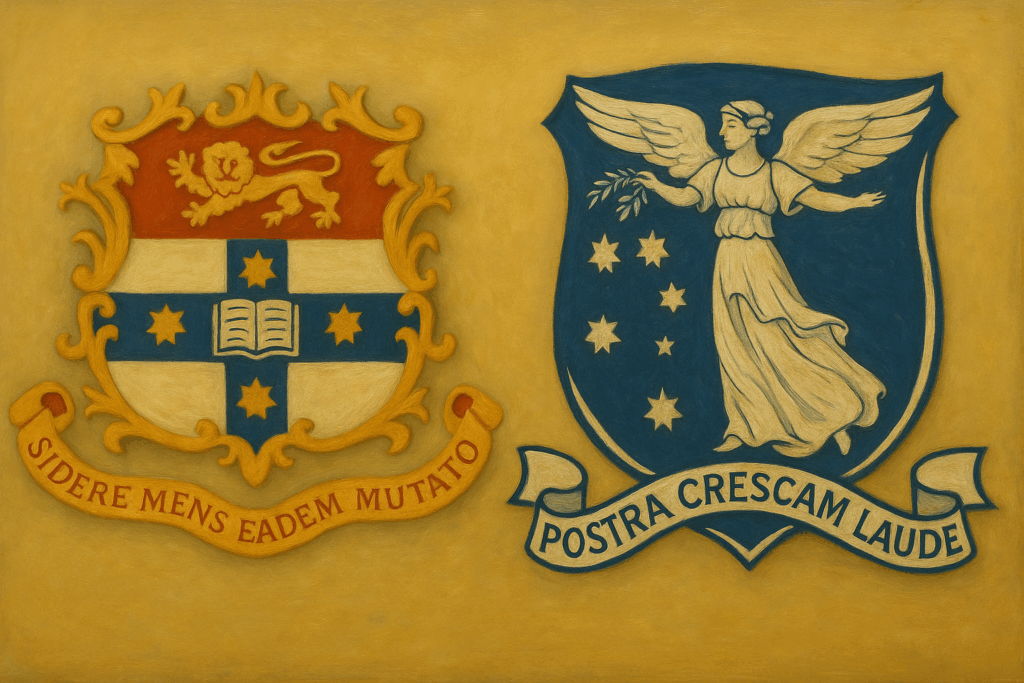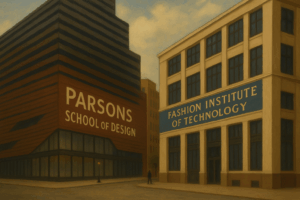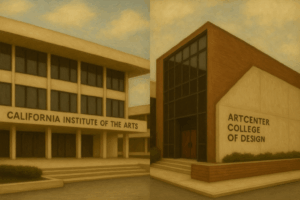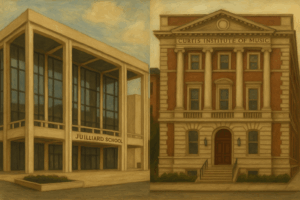
The GOAT of Australian Universities?
When considering studying in Australia, the University of Sydney and the University of Melbourne are always at the pinnacle of choices. As founding members of the ‘Group of Eight (Go8),’ Australia’s coalition of leading research-intensive universities, both institutions boast world-class academic prestige and social influence. They are more than just educational institutions; they play a key role in shaping the identity of their respective cities and leading the nation’s intellectual discourse.
Much like the long-standing rivalry between the cities of Sydney and Melbourne, the two universities have developed their own unique colors based on different histories, cultures, and academic philosophies. This article, based on the latest 2025 information, goes beyond a simple ranking comparison to provide a reliable guide that will help you make the optimal choice for your future by exploring the deep inner workings of both universities.
1. Global Prestige: Academic Standing in the 2025 Rankings
Overall Rankings Comparison
Both universities are firmly established as top-tier institutions, consistently placing within the world’s top 100. The University of Melbourne tends to show strength in research-focused metrics, while the University of Sydney excels in reputation and international collaboration indicators.
| Ranking Body | University of Sydney (2025-2026) | University of Melbourne (2025-2026) |
|---|---|---|
| QS World University Rankings | 18th (2025), 25th (2026) | 13th (2025), 19th (2026) |
| THE World University Rankings | 45th (2025) | 39th (2025) |
| ARWU (ShanghaiRanking) | 74th (2024) | 37th (2024) |
The Truth Beyond the Rankings: Research Power vs. Graduate Reputation
The University of Sydney shows strength in QS evaluation metrics such as ‘Employer Reputation’ and ‘International Research Network.’ This highlights the university’s global network and its close connections with society and industry.
The University of Melbourne consistently records high rankings in the THE and ARWU rankings. This is because these evaluation bodies place a high weight on research performance and paper citations, reflecting the University of Melbourne’s strong research-oriented culture.
2. History and Tradition: Laying the Foundation of Australian Higher Education
University of Sydney: Australia’s First University, The Spirit of a Pioneer
Founded in 1850, the University of Sydney holds the symbolic status of being Australia’s first university. It was established on the innovative principles of ‘religious tolerance’ and ‘academic merit,’ allowing admission based solely on academic ability, untethered to any specific religion or social status. This has given the University of Sydney the identity of a ‘pioneer’ that broke from old-world customs to cultivate talent that would lead a new society.
University of Melbourne: A Hall of Academia Born from the Golden Age
In 1853, the University of Melbourne was born amidst the wealth and vitality brought by the Victorian era’s ‘Gold Rush.’ Its founding purpose was to transplant European intellect and culture into the rapidly growing colony and to nurture an elite class to lead society.
The university’s motto, ‘Postera Crescam Laude’ (I shall grow in the praise of future generations), embodies a long-term vision of building a cultural legacy for the generations to come.
3. Academics and Educational Philosophy: Two Different Approaches
University of Sydney: A Hub of In-Depth Majors and Interdisciplinary Research
The University of Sydney offers a traditional curriculum that allows students to focus deeply on their chosen field of study from a relatively early stage. Additionally, it contributes to solving societal problems through large-scale interdisciplinary research institutes that span multiple academic fields.
- Charles Perkins Centre: Research on chronic diseases like obesity and diabetes.
- Brain and Mind Centre: Research on mental health and neurological disorders.
- Sydney Nano: Research in nanoscience and technology.
- Sydney Environment Institute: Explores climate change issues through a humanities and social sciences approach.
University of Melbourne: The Innovation and Controversy of the ‘Melbourne Model’
In 2008, the University of Melbourne introduced an innovative academic system called the ‘Melbourne Model.’
This model is designed for students to learn a broad range of liberal arts and foundational studies at the undergraduate level, with professional vocational training undertaken at the graduate level in professional schools. This structure, similar to academic systems in the US or Europe, has been positively received for providing opportunities to explore various disciplines and for cultivating flexible talent needed for a rapidly changing future society.
4. Campus Culture and Student Life: The Harmony of City and University
Sydney: The Center of Sunshine, Sea, and Free-Spirited Outdoor Activities
The campus culture of the University of Sydney is closely linked to the geographical characteristics of Sydney. The mild year-round climate and beautiful beaches provide the perfect environment for students to balance their studies with outdoor activities. The University of Sydney Union (USU), Australia’s oldest and largest student organization, supports over 200 clubs and societies and serves as the focal point of student life.
Melbourne: The City of Arts, Coffee, and European-Style Intellect
The unique atmosphere of Melbourne, often called the ‘cultural capital of Australia,’ is deeply ingrained in the campus culture of the University of Melbourne. The city’s graffiti art, distinctive cafes, and live music venues provide students with rich artistic inspiration. The University of Melbourne Student Union (UMSU) has a history and tradition of actively voicing opinions on social and political issues, which has contributed to fostering a culture where students are more responsive to societal problems.
5. Alumni Who Move the World: Cradles of Leaders
Notable Alumni from the University of Sydney
| Field | Representative Alumnus | Key Achievement |
|---|---|---|
| Politics/Public Service | Anthony Albanese | 31st Prime Minister of Australia. |
| Malcolm Turnbull | 29th Prime Minister of Australia. | |
| Michael Kirby | Former Justice of the High Court of Australia, international jurist. | |
| Noel Pearson | Indigenous rights activist and lawyer. | |
| Business/Technology | Robyn Denholm | Chair of the Board of Directors at Tesla, Inc. |
| James Wolfensohn | Former President of the World Bank. | |
| Arts/Culture | Jane Campion | Film director (Academy Award for Best Director). |
| Germaine Greer | World-renowned feminist writer and academic (Master’s). | |
| Science/Medicine | Charles Perkins | An iconic figure in the Australian Indigenous rights movement, football player. |
Notable Alumni from the University of Melbourne
| Field | Representative Alumnus | Key Achievement |
|---|---|---|
| Politics/Public Service | Julia Gillard | 27th Prime Minister of Australia (Australia’s first female PM). |
| Robert Menzies | 12th Prime Minister of Australia (longest-serving). | |
| Alfred Deakin | 2nd Prime Minister of Australia (‘Father of Australian Federation’). | |
| Business/Technology | James P. Gorman | Chairman and CEO of Morgan Stanley. |
| Arts/Culture | Cate Blanchett | Actress (two-time Academy Award winner for Best Actress). |
| Barry Humphries | Comedian and actor (creator of the ‘Dame Edna’ character). | |
| Germaine Greer | World-renowned feminist writer and academic (Bachelor’s). | |
| Science/Medicine | Peter Singer | World-renowned ethicist and philosopher. |
| Elizabeth Blackburn | Molecular biologist (Nobel Prize in Physiology or Medicine). | |
| Ian Frazer | Immunologist (developed the HPV vaccine ‘Gardasil’). |
Conclusion: The Choice for Your Future, Sydney vs. Melbourne
The University of Sydney: The Path of the ‘Pragmatic Pioneer’
As Australia’s first university, it has a history of cultivating talent based on merit, untethered to traditional authority. It will be an attractive choice for students who want to grow quickly as experts by delving deep into a specific field of study under a more traditional academic system, and for those who dream of a dynamic university life amidst the vibrant energy of Sydney.
The University of Melbourne: The Cradle of the ‘Innovative Intellectual’
Through its unique ‘Melbourne Model’ curriculum, the university encourages students to engage in broad academic exploration without being tied down to a specific major. It provides an optimal environment for students who have not yet decided on a clear career path or who want to forge their own way by integrating various disciplines. Students who prefer a culture of deep contemplation on social issues while being intellectually stimulated in the artistic and cultural city of Melbourne will find great satisfaction.
Ultimately, the choice between the two universities depends on your personal disposition and values. Do you want to move efficiently toward a clear goal, or do you want to grow flexibly by exploring various possibilities? Your answer to this question will be the most important criterion in deciding which of Australia’s two representative giants will be your partner for the future.


